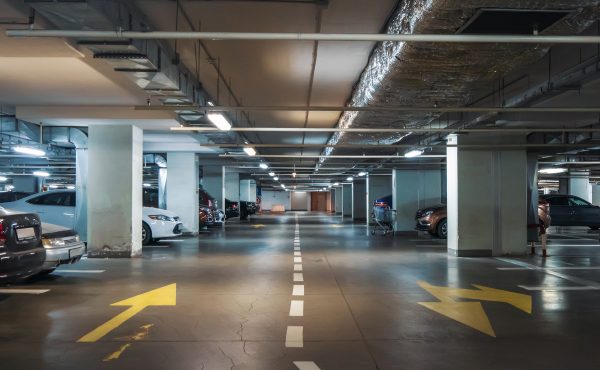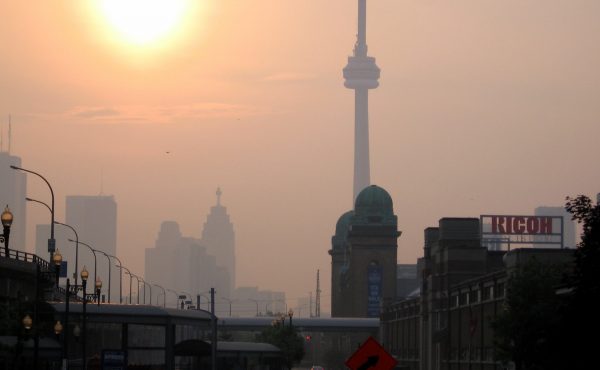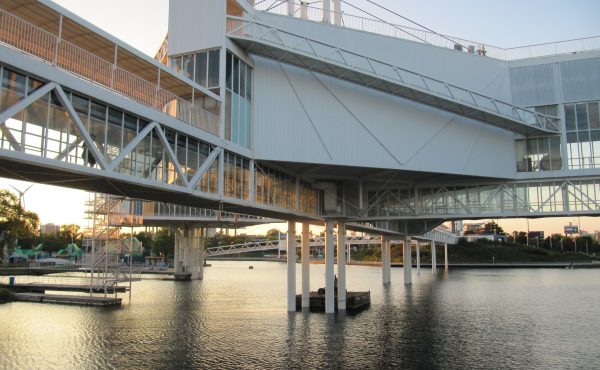
A press release (PDF) was issued today announcing that the Portlands Energy Centre, the embattled power plant going up in the Portlands, will host Canada’s largest solar research facility. In conjunction with U of T and Appropriate Renewable Intelligent Sustainable Energy Technologies Corporation (ARISE), the facility is projected to power 1000 homes and will also provide students with opportunities to research renewable energy sources. The PEC has made some efforts to convince Torontonians that it wants to be a good neighbour, including promises to improve bike paths and plant 3000 trees, but this latest step is surely the boldest yet.
Image courtesy of the Portlands Energy Centre.




9 comments
well that sounds delightful! now lets just get rid of the other part of the power plant.
Re. “embattled”: I know this is way too late, but perhaps if the opposed electricity generating plants were designed by Daniel Libeskind or Frank Gehry people would be more open to having them near or in their neighbourhoods. The artist and architect Friedensreich Hundertwasser designed several such utility buildings, including the Spittelau District Heating Plant in Austria (see http://flickr.com/photos/dogmycats/28094047/) and the Maishima Incineration Plant in Osaka (see http://www.flickr.com/photos/jgelens/152473071/). Both of these examples are fantastical and whimsical in their appearance and are popular tourist attractions. Incidentally, Hundertwasser was initially opposed to the idea the Spittelau heating plant which generates heat by incinerating garbage because he believed that not all possibilities for avoiding garbage had been exhausted. When he was promised that the plant would be equipped with the most modern purification technology and would heat 60000 apartments that would otherwise also be a source of emissions, he changed his mind. Closer to home, the beautiful art deco R.C. Harris Water Filtration Plant should serve as a reminder that it is possible to have both form and function in utility buildings.
Unfortunately this press release seems full of promise but empty of content. Installation in early 2009? Financial methods not yet decided? I hate to be cynical, but this story is fairly typical of ‘press releases’ we have seen lately, along with SkyPower’s ‘50MW of solar’ to be installed in 3 year’s time… In 3 year’s time the price of solar should have come down, making these projects viable, but for now they seem like a thinly veiled effort to raise stock prices or just gain media attention.
The only solar park that I know of in Ontario that is actually moving towards construction (in 2007) is Sunpark, in Guelph. Ironically this is just a stone’s throw away from ARISE Technologies office in Waterloo, and they’re not listed as a participant… Hmm…
Following on from Dave’s comment: now imagine its a solar plug in site for electric
minivans that are part of an internet computer based ttc service to get you where you need to go, or feed you into the subway.
A so-called good neighbour is not one that emits pollutants that will kill more people in Toronto ridings that already have the highest death rates due to air pollution. For less than a third of the the cost of building the plant we can conserve more electricity than the plant will ever produce. Conservation is better at preventing blackouts than plants are because plants go off line for many reasons while conservation (high efficiency, insulation and the like) is always up and running. This plant will poison our air, devastate our waterfront development and waste our money. Now is the time to push McGuinty to http://www.stoptheplant.ca
Premier McGuinty should know he can’t make a silk purse out of a sows ear. All the solar panels in the world won’t make PEC one iota safer.
http://www.youtube.com/watch?v=OBHVnT42UM0
Last Thursday the PR person from PEC, Ted Gruetzner, sent me a note with the PEC press release announcing the solar park, congratulating me on my contribution, as he met the solar researcher, Nazir Kherani, at a seminar I organized in May of 2006.
What seems to be lost on Mr. Gruetzner is that the principal speaker of the seminar I organized was Tim Hennessy, the CEO of VRB Power Systems, speaking about flow battery technology which could one day eliminate the need for peaking plants altogether. So what I’d really like to see is a flow battery research facility tied to the solar park with no PEC at all. THAT would be progress.
I remember listening to someone calling in to a radio program last summer
when the topic was the PEC, saying:
“If we need this energy the most during peak heat waves in the summer, doesn’t that mean the sun is likely beating down to create that heat? Wouldn’t it be deliciously ironic to harness that solar energy to feed the hungry air conditioners, rather than creating more pollution and GGs with a fossil-fuel burning generator? ”
This plan is a clever diversion, the microscopic scale being, as councillor Gord Perks points out “not only a joke, but an insult”.
The movement for serious solutions to the threats of global climate change is gaining momentum, though it looks like Dalton and Dwight are waving from the sidelines.
Fun with numbers: $5 million for the solar park vs. $730 million to build the gas plant. That whopping 0.7% is a very shrewd public relations investment by PEC!
More fun with numbers: $730 million to build a 550 MW plant vs. $40 million invested in conservation by Toronto Hydro to save 250 MW.
Some numbers I don’t have: cost of constructing the pipeline to deliver the gas to the plant; price of declining supply of natural gas burned to produce the electricity; costs to health care system to treat illnesses caused by air pollution from fossil fuel burning power plants; costs to mitigate damage of global warming.
One final number: estimated annual deaths in Toronto due to air pollution: 1800.